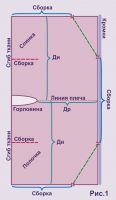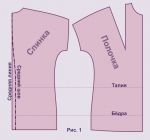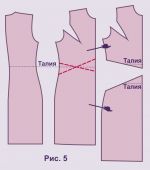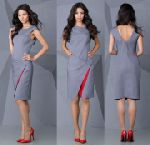 In this article, we will analyze examples of modeling dress patterns with pleats or gathers converging at one point.
In this article, we will analyze examples of modeling dress patterns with pleats or gathers converging at one point.
Let's conditionally call this point a "knot" and look into the features of styles unmodeled on various bases.
Let's start with the simplest style variations that beginner couturiers can sew on their own.
1. We model a dress pattern as in photo 1
Dress left on Photo 1 on the left, you can generally sew without a pattern (picture 1). The fabric is a knitted fabric imitating hand knitting.
Consumption - two lengths of the product (Di).
The neck is cut arbitrarily (but symmetrically!).
Assembly type "node" can be performed directly on the figure.
type "node" can be performed directly on the figure.
The corners between the assembly areas (green dotted line) can be cut along a straight or concave line.
The model featured on Photo 1 on the left, can also be made from a fabric rectangle, like the previous one.
But, the best fit will give a dress made on the basis of "kimono"
 ("kimono" without tuck download pattern for free
("kimono" without tuck download pattern for free
и
 "kimono" with chest tuck download almost free, but life size, sizes 42-62).
"kimono" with chest tuck download almost free, but life size, sizes 42-62).
Having made a pattern according to any “kimono” pattern (picture 2), mark the waist line and "turn" the half-skid line for the bodice and for the bottom, make a cut at the waist, as shown in 2 drawing.
2. We model a dress pattern, as in photo 2
 On the Photo 2 a fundamentally different style of the “knot” is shown, which implies the presence of cutting and sewing skills, as well as the basis of a semi-adjacent silhouette (
On the Photo 2 a fundamentally different style of the “knot” is shown, which implies the presence of cutting and sewing skills, as well as the basis of a semi-adjacent silhouette (
 download almost free pattern-base in full size, sizes 42-62).
download almost free pattern-base in full size, sizes 42-62).
I must say right away that sewing without trying on will not work.
Horo sho that this dress can be sewn from almost any fabric that is not too thick.
sho that this dress can be sewn from almost any fabric that is not too thick.
Please note that the style will not suit women with a protruding lower abdomen, but it will sit perfectly on the “apples” if the “knot” is located below the most protruding point.
After completing the base patterns (picture 3), we determine the position of the “knot” in accordance with the features of the customer’s physique and draw fan-shaped cut lines.
We cut from the “knot” to the top of the tuck and the seams, but do not cut a couple of millimeters.
We lay the cut pattern of the shelf on a plastic film (paper or directly on the fabric, if you have enough experience) and circle the parted petals (picture 4).
Please note that the angles between the petals are approximately the same.
Exceptions are the angle formed after closing the tuck and the angle between the half-slide of the base and the half-slide of the unmodeled pattern.
The last one is half the size of the others.
When spreading the petals, keep in mind that the shelf should go the width of the fabric, that is, its width should be 70 - 75 cm in the end.
Please note that we cut out the back for fitting exactly according to the pattern-base and outline the neckline, sprout and cut line of the back and adjust it during the fitting.
3. We model a pattern for a dress, as in photo 3
 The style shown in Photo 3, can be cut out according to different bases:
The style shown in Photo 3, can be cut out according to different bases:
 download the pattern of the stretch base for free
download the pattern of the stretch base for free
 download this base almost for free in full size, sizes 42-52 - the choice is yours).
download this base almost for free in full size, sizes 42-52 - the choice is yours).
 2. On a base with an armhole tuck, which can be bought at the pattern store (sizes 42-62).
2. On a base with an armhole tuck, which can be bought at the pattern store (sizes 42-62).
 The base with a tuck is recommended for busty girls and ladies.
The base with a tuck is recommended for busty girls and ladies.
We start modeling by defining the contour of the shelf (picture 5) - we draw two intersecting lines for the bodice and skirt. We carry out the patterns of both parts.
We plan cuts from "knots" (picture 6), keeping the waist line as the line of intersection of the parts of the shelf.
cuts from "knots" (picture 6), keeping the waist line as the line of intersection of the parts of the shelf.
When cutting, we also save the waist line marks on the details of the shelf (picture 7).
4. Patterns of dresses of cases for printing on a printer












 Join my community on Viber...
Join my community on Viber...











